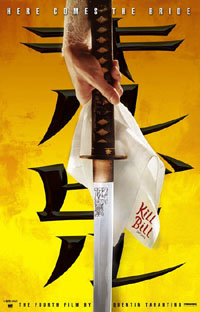 KILL BILL VOL.1
KILL BILL VOL.1(R)
**** (out of 5)
October 10, 2003
STARRING
Uma Thurman as THE BRIDE/BLACK MAMBA
Lucy Liu as O-REN ISHI/COTTONMOUTH
Vivica A. Fox as VERNITA GREEN/COPPERHEAD
Darryl Hannah as ELLE DRIVER/CALIFORNIA MOUNTAIN SNAKE
Michael Madsen as BUDD/SIDEWINDER
David Carradine as BILL
Directed by: Quentin Tarantino
BY KEVIN CARR
You’d think by the hype surrounding the long-awaited release of “Kill Bill, Vol. 1,” which is chronically and annoyingly billed as “The Fourth Film from Quentin Tarantino,” you’d think the movie could cure cancer. So, let’s cut to the chase (or in honor of Tarantino, let’s cut to the gunfight).
If you’re a die hard Tarantino fan – and by die-hard, I mean you saw “Reservoir Dogs” when it first came to theaters and bought “Switchblade Sisters” because it had Tarantino’s name on it – then you’re going to love “Kill Bill.” It delivers on every classic Tarantino brand that you’d come to expect from his other films: non-chronological storyline, gangster characters, funky 70s-style music, snappy dialogue spattered with pop culture references, and lots and lots of violence.
Uma Thurman plays The Bride with no name. (Well, actually, she has a name, but it is bleeped out whenever a character uses it.) Four years ago, she was assassinated – along with everyone in her wedding party – by the Death Viper Assassination Squad (Lucy Liu, Darryl Hannah, Vivica A. Fox and Michael Madsen). The only problem is that The Bride ended up surviving the hit. After being comatose since “Jackie Brown” hit video stores, The Bride wakes up with a thirst for revenge. She makes a hit list of the four assassins with whom she used to work, and she tops it off with Bill, her old boss who ordered her death four years before.
Aside from “Kill Bill” being Tarantino’s return to directing in more than half a decade, the other big news surrounding the film is the decision by Miramax to release it in two parts. Now, I understand the financial reasons for this. Miramax is playing the odds here, hoping that they can have two big releases and dilute the more than $50 million budget (i.e., two Tarantino films at half price). However, I can’t help have a bitter taste in my mouth from this. I’m lucky enough to see screeners as a reviewer, but if I had to pay money for these two films, I’d be irked at having to buy two tickets to see the whole film.
Sure, “Kill Bill: Vol. 1” ends with a cliffhanger. You can expect as much. But it’s a weak cliffhanger. Real cliffhangers that paved the way for a sequel include films like “The Empire Strikes Back,” “Back to the Future: Part II” and even this summer’s “The Matrix: Reloaded.” While these were complete films that had a lot left open in the end for resolution in another film, “Kill Bill: Vol. I” really just feels like they arbitrarily divided the print into two piles – one for October and one for February. It really feels much more like a two-part television miniseries than a movie that needs a sequel.
Aside from the possible pay-off on the financial gamble, one of the biggest factors driving the break up of “Kill Bill” into two volumes was its running time, which is considerable. In this respect, it was a good decision because a four-hour “Kill Bill” conglomeration would have been excruciating. On the other hand, Miramax should have exercised some more control over Tarantino and forced him to cut more from the film. To say Tarantino indulged himself on this film is an incredible understatement. There was at least forty minutes of padding that he used to stretch the time, and the editor should have taken a Samurai sword to the climactic battle between The Bride and the Crazy 88’s.
Now that’s he’s back in the news for actually making a film, Tarantino is now being compared to Stanley Kubrick rather than Orson Welles (to whom he was compared around the release of “Pulp Fiction”). Most of this comparison comes from the ultra-long wait fans had between “Jackie Brown” and “Kill Bill.” But Tarantino is no Kubrick – at least not yet. I can’t pretend to know all the reasons why he directed nothing in six years, but I’m sure they’re different than those of Kubrick. Plus, because Tarantino’s body of work is so slim for such a celebrated director, we have yet to see if the Tarantino style is consistent and if he can work outside of his own parameters.
Now, some have berated this film for how violent it is. But is really any great surprise? The violence here is total cartoon. Sure, it’s bloody cartoon, but it’s cartoon nonetheless. It’s not disturbingly brutal like the Van Gogh scene from “Reservoir Dogs.” In fact, much of the violence (which is dominated by Samurai sword-fighting) is actually quite comical. You’d never realize the Japanese had such high blood pressure, but after watching characters literally explode into a fountain of blood when they lose a limb or a hand, you gotta think their diet isn’t as healthy as we once thought.
If you have an appetite for Tarantino flicks, “Kill Bill” is going to taste really good. But if he were more prolific (like his indie film brother Robert Rodriguez, who has made more movies in the past year than Tarantino has in the last decade), it could get kinda stale.
Still, with all of its faults, long-windedness and Tarantino self-love, “Kill Bill: Vol. 1” is still a fun film. It’s no “Pulp Fiction,” but that was never Tarantino’s intention. He just wanted to make a kick-ass kung-fu flick. And he did just that.
